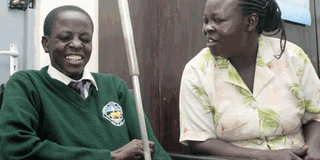Hi-tech help for people with disabilities

Moses Mulama blind student at Aquinas High School chats with his mother Grace Vienda. A new generation of gadgets, gizmos and software is making it easier for the disabled to do things that would not have been possible before. PHOTO | JAMES NJUGUNA |
What you need to know:
- A new generation of gadgets, gizmos and software is making it easier for the disabled to do things that would not have been possible before.
- They can interact with others and get work done without hitting the roadblocks that older technologies imposed.
- By using computing technology for tasks such as reading and writing documents, communicating with others, and searching for information on the Internet, people with disabilities are capable of handling a wider range of activities independently.
- Smartphones, tablets and smartwatches are helping people with intellectual and developmental disabilities live more independently.
People with disabilities meet barriers of all types, but technology is helping to lower many of these barriers.
A new generation of gadgets, gizmos and software is making it easier for the disabled to do things that would not have been possible before.
They can interact with others and get work done without hitting the roadblocks that older technologies imposed.
By using computing technology for tasks such as reading and writing documents, communicating with others, and searching for information on the Internet, people with disabilities are capable of handling a wider range of activities independently.
Smartphones, tablets and smartwatches are helping people with intellectual and developmental disabilities live more independently.
Systems that read text messages aloud are a great help in the lives of visually impaired individuals.
TECHNOLOGY
Additionally, similar technology can be used within apps on phones to allow visually impaired people the chance to use the technology.
Apps such as Instagram can have on screen text and commands read aloud to enable users to use the service without being dependent on sight.
People with severe reading disabilities may benefit from computer programmes that can scan words and “read” them aloud via synthesised voices, some of which sound uncannily human.
One such is the Intel Reader, a device that can plug into a laptop for reading on-screen texts and also takes snapshots of, say, a newspaper page to be read aloud.
Another is the ReadingPen Advanced. This a pen-shaped scanner that glides over printed words and pronounces them through a built-in speaker.
Other designers and scientists are developing wearables that can help people with even the most severe disabilities better navigate and communicate.
In addition, with VoiceOver, the iPhone’s built-in gesture-based app that reads text on a touch-screen aloud, or Google Android’s TalkBack, blind users can access anything on their phones.
APPS
The user activates apps with a few gestures, single finger to explore and find buttons, one-finger touch to identify things on the screen, and double-tap to push the button after it’s located.
Other assistive hardware includes smartpens such as Livescribe and Echo that record lessons for students who have memory or note-taking problems.
When reviewing their notes, students can tap anywhere on their written notes and the corresponding audio is replayed.
Anxiety is reduced as students can relisten to the class, picking up things they have missed due to say dyslexia or attention deficit disorder.
Voice control systems such as Nuance allow users to dictate messages to be typed on computers and phones, while also converting displayed text on phones into intelligible speech.
The former function is particularly of benefit to people with learning disabilities such as dyslexia as it lets them express their ideas in papers without the frustration of written assignments.
IPADS, TABLETS
Many parents of children with autism are turning to iPads and other tablets to enable their kids to communicate, practice eye contact and learn new vocabulary.
Children enjoy the repetitiveness of the computer’s speech functions and appear to be less distracted when using tablets instead of traditional alphabet sheets when communicating.
Fitness bands allow people to monitor the steps they take, their heart rate and sleep patterns as well as the amount of food they eat and water they drink.
There has been a huge growth in devices aimed at the autistic market that allow people to track someone with autism.
Whereas some of these technology tools may not be found in Kenya, it is not too difficult nowadays to order from the countries where they are available.
Organisations that work with people with disabilities such as the Association of People with Disabilities in Kenya can offer advice on how to get these technologies.
Sam Wambugu is an informatics specialist; [email protected]; Twitter: @samwambugu2





